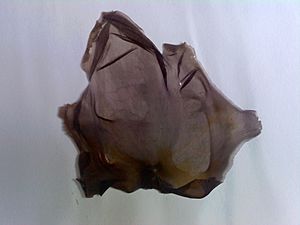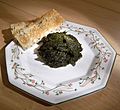Laverbread facts for kids
Quick facts for kids Laverbread |
|
|---|---|
 |
|
| Laverbread and toast | |
| Scientific classification | |
| Genus: |
Porphyra
|
| Species: |
umbilicalis
|
| Nutritional value per 100 g (3.5 oz) | |
|---|---|
| Energy | 146 kJ (35 kcal) |
|
5.11 g
|
|
| Sugars | 0.49 g |
| Dietary fiber | 0.3 g |
|
0.28 g
|
|
|
Protein
|
5.81 g
|
| Vitamins | Quantity
%DV†
|
| Vitamin A equiv.
beta-Carotene
|
33%
260 μg
29%
3121 μg |
| Thiamine (B1) |
9%
0.098 mg |
| Riboflavin (B2) |
37%
0.446 mg |
| Niacin (B3) |
9%
1.47 mg |
| Pantothenic acid (B5) |
10%
0.521 mg |
| Vitamin B6 |
12%
0.159 mg |
| Folate (B9) |
37%
146 μg |
| Vitamin C |
47%
39 mg |
| Vitamin E |
7%
1 mg |
| Vitamin K |
4%
4 μg |
| Minerals | Quantity
%DV†
|
| Calcium |
7%
70 mg |
| Iron |
14%
1.8 mg |
| Manganese |
47%
0.988 mg |
| Phosphorus |
8%
58 mg |
| Potassium |
12%
356 mg |
| Sodium |
3%
48 mg |
| Zinc |
11%
1.05 mg |
|
Link to USDA Database entry
|
|
| †Percentages estimated using US recommendations for adults. | |
Laverbread (Welsh: bara lafwr or bara lawr) is a special food from Wales. It is made from an edible seaweed that grows along the coasts. This seaweed is mostly found around the west coast of Great Britain and the coasts of Ireland. In Ireland, it is known as sleabhac.
The seaweed used for laverbread is smooth and looks like delicate sheets. It often sticks to rocks. The main type of seaweed used is called Porphyra umbilicalis. This seaweed is a type of red algae. Even though it is called red algae, it usually looks brownish. However, when it is cooked, it turns into a dark green, soft paste.
Laver seaweed is very good for you! It has a lot of dietary minerals, especially iodine and iron. The high iodine content gives it a unique flavor, similar to olives and oysters. People in Wales have been eating laverbread for a very long time, at least since the 1600s.
Contents
Making Laverbread: From Seaweed to Plate
Laverbread is made by carefully washing the seaweed many times. This removes any sand or bits of rock. After washing, the seaweed is boiled for several hours. This process turns it into a soft, purée-like product. The cooked seaweed becomes a gelatinous (jelly-like) paste.
This paste can be sold as it is, or it can be mixed with oatmeal. Sometimes, it is coated with oatmeal before being fried. Laverbread is a traditional part of a Welsh breakfast. It is often eaten fried with bacon and cockles. In the southwest of England, it might be served with hog's pudding.
The Seaweed: Porphyra umbilicalis
The seaweed used to make laverbread is Porphyra umbilicalis. It belongs to the genus Porphyra. This seaweed is common along the west coast of Great Britain and the east coast of Ireland, especially in the Irish Sea. In Ireland, it is also called sleabhac or slake.
This seaweed has a smooth texture and forms thin, sheet-like fronds (leaves). These fronds often cling to rocks. Porphyra is classified as red algae. It usually looks brownish, but when cooked, it turns into a dark green pulp. It is special because its fronds are only one cell thick!
Laver seaweed is packed with dietary minerals, like iodine and iron. The high iodine content gives it a distinct flavor, similar to olives and oysters.
Traditional Preparation and Serving
To make laverbread, the seaweed is boiled for many hours. Then, it is minced or pureed into a smooth, thick paste. This jelly-like paste is then ready to eat. It can be sold plain or rolled in oatmeal. Sometimes, it is coated with oatmeal before being fried.
Laverbread is a traditional Welsh food. It is often eaten fried with bacon and cockles as part of a Welsh breakfast. You can also use it to make a sauce for lamb, crab, or monkfish. There's even a laver soup called cawl lafwr. The famous actor Richard Burton once called laverbread "Welshman's caviar"!
Laver seaweed is often linked to Penclawdd and its cockles. It has been a key part of the Welsh diet for a long time. Besides Wales, laverbread is also eaten in North Devon, England, especially along the Exmoor coast. In North Devon, it is usually just called 'laver' and is not cooked with oatmeal.
Health Benefits of Laverbread
Laverbread is very healthy! It has a lot of protein, iron, and especially iodine. The dried purple version of this seaweed, known as nori, is also one of the few plants that naturally contain a good amount of Vitamin B12. This makes it a great source of Vitamin B12 for vegans.
Images for kids



